Electrochemical sensors for environmental monitoring. Strategy and ...
Electrochemical sensors for environmental monitoring. Strategy and ...
Electrochemical sensors for environmental monitoring. Strategy and ...
Create successful ePaper yourself
Turn your PDF publications into a flip-book with our unique Google optimized e-Paper software.
Pure Appl. Chem., Vol. 73, No. 12, pp. 1969–1977, 2001.<br />
© 2001 IUPAC<br />
<strong>Electrochemical</strong> <strong>sensors</strong> <strong>for</strong> <strong>environmental</strong><br />
<strong>monitoring</strong>. <strong>Strategy</strong> <strong>and</strong> examples*<br />
Christopher M. A. Brett<br />
Departamento de Química, Universidade de Coimbra, 3004-535 Coimbra,<br />
Portugal<br />
Abstract: The strategy <strong>and</strong> useful applications of electrochemical <strong>sensors</strong> <strong>for</strong> <strong>environmental</strong><br />
<strong>monitoring</strong> are surveyed. Potential benefits <strong>and</strong> important design factors are outlined. Trends<br />
in important areas are focused on with illustrative examples, <strong>and</strong> future perspectives are considered.<br />
INTRODUCTION<br />
In recent years, increased concerns with the toxic effects of chemicals in the environment have led to<br />
the necessity of <strong>monitoring</strong> pollutant levels at various points in industrial processes <strong>and</strong> recycling<br />
processes, in effluents <strong>and</strong> wastewaters, <strong>and</strong> at industrial, agricultural, <strong>and</strong> urban sites. Additionally,<br />
continuous <strong>monitoring</strong> of <strong>environmental</strong> pollution in the field requires portable fast-response <strong>sensors</strong><br />
that are robust <strong>and</strong> with sufficient sensitivity <strong>and</strong> long lifetime.<br />
This paper examines the contribution electrochemical <strong>sensors</strong> <strong>and</strong> electroanalysis [1,2] can make<br />
to this strategy. Some of the criteria to be considered are shown in Fig. 1. First, the usefulness of elec-<br />
Fig. 1 Important aspects <strong>for</strong> choosing electrochemical <strong>sensors</strong> <strong>for</strong> <strong>environmental</strong> <strong>monitoring</strong>.<br />
*An issue of reviews <strong>and</strong> research papers based on presentations made at the IUPAC/ICSU Workshop on Electrochemistry <strong>and</strong><br />
Interfacial Chemistry in Environmental Clean-up <strong>and</strong> Green Chemical Processes, Coimbra, Portugal, 6–7 April, 2001.<br />
1969
1970<br />
C. M. A. BRETT<br />
trochemical <strong>sensors</strong> <strong>for</strong> <strong>environmental</strong> <strong>monitoring</strong> will be assessed, including the role they can play,<br />
design factors, <strong>and</strong> how selectivity can be achieved. Following this, recent examples from the literature<br />
will be given <strong>and</strong> an indication of future trends will be presented.<br />
WHY ELECTROCHEMICAL SENSORS?<br />
The three types of electroanalytical measurement that can be per<strong>for</strong>med each offer different degrees of<br />
selectivity [1]:<br />
Conductimetric. The concentration of charge is obtained through measurement of solution resistance<br />
<strong>and</strong> is there<strong>for</strong>e not species-selective. Conductimetric detectors can, however, be useful in situations<br />
where it is necessary to ascertain, <strong>for</strong> example, whether the total ion concentration is below a certain<br />
permissible maximum level or <strong>for</strong> use as an on-line detector after separation of a mixture of ions<br />
by ion chromatography. Such situations can arise in electroremediation.<br />
Potentiometric. The equilibrium potential of an indicator electrode is measured against a selected<br />
reference electrode using a high-impedance voltmeter, i.e., effectively at zero current. Thus, the current<br />
path between the two electrodes can be highly resistive. At an inert redox indicator electrode such<br />
as platinum the potential measured is a mixed potential, a function of all species present in solution <strong>and</strong><br />
their concentrations. In ion-selective electrodes, careful choice of electrode material can give good<br />
selectivity to one particular species, in many cases, with only minimal interference from other ions.<br />
Detection limits of the order of 100 nanomoles per litre of the total concentration of the ion present in<br />
a particular oxidation state, although down to 10 picomolar differences in concentration can be measured.<br />
Voltammetric. Where the current is registered as a function of applied potential, more in<strong>for</strong>mation<br />
<strong>and</strong> lower detection limits can usually be gained. Several species that react at different applied potentials<br />
can be determined almost simultaneously in the same experiment without the need <strong>for</strong> prior separation.<br />
Very low detection limits of down to the picomolar level can be reached using state-of-the-art<br />
instrumentation <strong>and</strong> preconcentration of the analyte on the electrode surface. In many practical <strong>sensors</strong><br />
or detectors used after separation, e.g., by high-pressure liquid chromatography or capillary electrophoresis,<br />
or in detectors in continuous flow, after the voltammetric profile has been investigated,<br />
amperometric <strong>sensors</strong> at fixed potential can be employed.<br />
The potential benefits of electrochemical <strong>monitoring</strong>, using the above types of measurement, in<br />
an <strong>environmental</strong> context are:<br />
1. An applied potential in voltammetric <strong>sensors</strong> can lead to high selectivity <strong>and</strong> specificity, <strong>and</strong><br />
thence probing of speciation. Each chemical species as well as each element or oxidation state<br />
has an associated potential <strong>for</strong> oxidation <strong>and</strong> reduction. Such specificity is not possible with most<br />
other analytical techniques.<br />
2. The choice of electrode material can lead to selectivity, particularly in ion-selective electrodes. In<br />
voltammetric <strong>sensors</strong> <strong>and</strong> at some electrode materials, certain species do not react, so that interference<br />
problems may be resolved in this way. An obvious example is the high overpotential <strong>for</strong><br />
hydrogen evolution at mercury electrodes.<br />
3. Modern electrochemical instrumentation, particularly with controlled potential, associated with<br />
voltammetric <strong>sensors</strong>, leads to high sensitivity <strong>and</strong> low detection limits, since complex applied<br />
potential programs can be used together with accumulation of the species to be measured at the<br />
electrode surface.<br />
4. There is the possibility of furnishing not only the results but also treated data in real time or close<br />
to real time, using computerized control <strong>and</strong> particularly in flow systems <strong>for</strong> on-line <strong>monitoring</strong>.<br />
5. Portable <strong>sensors</strong> with dedicated instrumentation, possibly battery-powered, that can be used outside<br />
the laboratory.<br />
6. Miniaturized <strong>sensors</strong>, <strong>for</strong> application in situations where other probes may not be usable.<br />
© 2001 IUPAC, Pure <strong>and</strong> Applied Chemistry 73, 1969–1977
<strong>Electrochemical</strong> <strong>sensors</strong> <strong>for</strong> <strong>environmental</strong> <strong>monitoring</strong> 1971<br />
Thus, electroanalysis is complementary to other analytical techniques. In the field, many of the<br />
existing analytical techniques cannot be applied as they require complex <strong>and</strong> large equipment, <strong>and</strong> so,<br />
electrochemical <strong>monitoring</strong> can bring many advantages. In the laboratory, the detection limits possible<br />
in electroanalysis make it a strong competitor <strong>for</strong> many other analytical techniques when alternatives<br />
exist.<br />
The advantage of distinguishing oxidation states is highly important. The electrochemical<br />
approach can give a rapid answer, without digestion, as to the labile fraction of a given element in a particular<br />
oxidation state, <strong>and</strong> the experiment can be per<strong>for</strong>med on-site in the field.<br />
GENERAL SENSOR DESIGN CRITERIA<br />
A useful electrochemical sensor must obey a number of experimental design criteria, many of which<br />
are linked to its potential benefits. Among the most important are:<br />
(a) For amperometric <strong>and</strong> voltammetric <strong>sensors</strong>, the species to be determined is electroactive within<br />
the sensor’s potential range, <strong>and</strong> whether there is the addition of an inert, supporting electrolyte<br />
to carry the current perturbs the equilibria in solution.<br />
(b) For potentiometric <strong>sensors</strong>, there is an adequate electrode material, free from interferences.<br />
(c) The concentration of electroactive species can be determined with sufficient accuracy <strong>and</strong> precision.<br />
(d) The measurements are sufficiently reliable <strong>and</strong> repeatable.<br />
(e) The response time of the sensor is sufficiently fast.<br />
(f) The drift or diminution of sensor response with time owing to electrode degradation or surface<br />
fouling is sufficiently small.<br />
(g) Calibration is simple <strong>and</strong> easy to per<strong>for</strong>m, or not necessary.<br />
(h) The detection limit is sufficiently low <strong>for</strong> the purpose envisaged.<br />
The relative importance of these factors depends on the <strong>monitoring</strong> necessities as well as on the<br />
technique employed <strong>and</strong> the electrode <strong>and</strong> cell configuration.<br />
It is important to bear in mind possibilities <strong>and</strong> advantages arising from:<br />
• self-contained test modules<br />
• specific assays<br />
• miniaturization<br />
• no external pretreatment or necessity of reagent addition.<br />
RECENT TRENDS IN SENSORS<br />
In this section, some recent trends <strong>and</strong> currently important aspects relating to the development <strong>and</strong><br />
applications of electrochemical <strong>sensors</strong> <strong>for</strong> <strong>monitoring</strong> will be given, together with illustrative examples,<br />
see Table 1. Several of these have recently been discussed elsewhere [3–5]. Little emphasis will<br />
be given to hyphenated techniques in the context of this contribution.<br />
Materials <strong>for</strong> potentiometric <strong>sensors</strong><br />
Recent tendencies in development of potentiometric <strong>sensors</strong> <strong>for</strong> <strong>monitoring</strong> have been the production<br />
of <strong>sensors</strong> that are more robust, more reliable (i.e., needing less calibration with smaller potential drift)<br />
<strong>and</strong> can be used in an ever wider range of situations with low maintenance.<br />
Potentiometric <strong>sensors</strong> based on plasticized PVC membranes doped with neutral carriers have<br />
been extensively developed <strong>for</strong> many ions [6,7]. For example, crown <strong>and</strong> bis-crown ether ionophores<br />
can be incorporated into polymer membranes, the recognition coming from the size of the host cavity<br />
© 2001 IUPAC, Pure <strong>and</strong> Applied Chemistry 73, 1969–1977
1972<br />
C. M. A. BRETT<br />
Table 1 Trends, difficulties <strong>and</strong> examples in the development <strong>and</strong><br />
applications of electrochemical <strong>sensors</strong> <strong>for</strong> <strong>environmental</strong> <strong>monitoring</strong>.<br />
Materials <strong>for</strong> potentiometric <strong>sensors</strong><br />
New electrode materials <strong>for</strong> heavy metal detection<br />
Flow <strong>and</strong> sample conductivity<br />
Instrumentation<br />
Poisoning of electrode surfaces<br />
Bio<strong>sensors</strong> <strong>and</strong> detectors <strong>for</strong> pesticides<br />
Toxicity <strong>sensors</strong><br />
or through specific metal–lig<strong>and</strong> interactions; an alternative with similar properties is calixarenes (phenol-<strong>for</strong>maldehyde<br />
condensates) derivatized to bind metal ions. A different route is to electropolymerize<br />
conducting polymer monomers from a solution containing the counteranion that it is desired to measure<br />
in order to tailor the cavity size in the film to that ion. There is much ef<strong>for</strong>t in improving selectivity<br />
relative to interfering species through chemical recognition principles.<br />
New electrode materials <strong>for</strong> heavy metal detection<br />
The useful ranges of applied potential at electrode materials <strong>for</strong> voltammetry are determined by oxidation<br />
or reduction of the solvent, decomposition of the supporting electrolyte, oxidation/reduction of the<br />
electrode surface, or even electrode dissolution. It is also usually necessary that the electrode material<br />
is inert in the region of potential in which the electroanalytical determination is carried out.<br />
For reduction reactions such as those of metal cations, liquid mercury was used extensively since<br />
the 1920s in the <strong>for</strong>m of the dropping mercury electrode <strong>and</strong> later as the hanging/static mercury drop<br />
electrode. Mercury’s useful potential range is limited by its oxidation, which means that essentially only<br />
reductions can be investigated.<br />
In stripping voltammetry of heavy metals, the metal is reduced <strong>and</strong> accumulated at the electrode<br />
over a period of time <strong>and</strong> then reoxidized [8]. In order to avoid hydrogen evolution, this has meant that<br />
until recently the electrodes must be mercury, usually mercury thin film or incorporating mercury salts<br />
[9]. There have been many applications of stripping voltammetry in <strong>environmental</strong> <strong>monitoring</strong> [9], <strong>and</strong><br />
many ways suggested of reducing the amount of mercury necessary. The preconcentration step enables<br />
detection limits that are well below the levels permitted by <strong>environmental</strong> legislation, <strong>and</strong> such analyses<br />
can often measure the amount of labile species or that which is weakly complexed, not the total<br />
amount. As a recent example of <strong>environmental</strong> importance, it was found that filtering of the analyte <strong>and</strong><br />
medium exchange was sufficient to measure the speciation of heavy metals in wastewater from a<br />
sewage treatment plant [10]. Nevertheless, this strategy may well not work in the long term.<br />
Although liquid mercury has been largely replaced by mercury thin films in recent years, these<br />
thin films have to be <strong>for</strong>med, <strong>and</strong> although the amount of mercuric ions can be regarded as very small,<br />
it is a route which may be unacceptable to the community in the near future. Thus, it is important to<br />
move toward different materials <strong>and</strong> non-mercury sensor materials.<br />
Successes have been registered, particularly with regard to carbon materials, which have already<br />
had much application in recent decades, in the positive potential range <strong>for</strong> studying oxidations [11] as<br />
well as substrate <strong>for</strong> mercury thin films. Good results have been obtained in the negative potential range<br />
with thick carbon films [12], boron-doped diamond [13], <strong>and</strong> carbon film electrodes made from carbon<br />
resistors [14]. A short survey of recent progress is found in [14]. Environmentally important ions such<br />
as lead, cadmium, <strong>and</strong> copper can be determined at many of these carbon materials. A greater challenge<br />
is to be able to measure zinc ions at submicromolar levels, since reduction of zinc ions occurs at more<br />
negative potentials <strong>and</strong> is usually concurrent with hydrogen evolution at most electrode materials—this<br />
has been shown to be possible in [14] <strong>and</strong> holds much promise <strong>for</strong> the future. At the same time, the carbon<br />
film electrodes are cheap, so they can be used as disposable <strong>sensors</strong>.<br />
© 2001 IUPAC, Pure <strong>and</strong> Applied Chemistry 73, 1969–1977
<strong>Electrochemical</strong> <strong>sensors</strong> <strong>for</strong> <strong>environmental</strong> <strong>monitoring</strong> 1973<br />
Flow <strong>and</strong> sample conductivity<br />
In many natural industrial <strong>and</strong> <strong>environmental</strong> situations, the analyte is under flowing conditions, which<br />
facilitates multicomponent detection either in parallel or sequentially, <strong>and</strong> ensures that there is no<br />
reagent depletion or build-up of reaction products. This is one way to approach the ideal of real-time<br />
analysis. Nevertheless, to obtain a reproducible response, it is important that any convective flow is<br />
understood, characterized, <strong>and</strong> modeled, or is constant. Alternatively, the effects of flow on sensor<br />
response are minimized as with microelectrodes, see below. Many <strong>sensors</strong> have been developed over<br />
the last decades <strong>for</strong> <strong>monitoring</strong> in flow systems [15].<br />
A disadvantage of flow is that it can degrade the sensor surface (mainly in ion-selective electrodes),<br />
can foul or block it. Fouling is usually best prevented by protecting the electrode surface <strong>and</strong>/or<br />
minimizing contact between analyte <strong>and</strong> electrode. The latter is difficult in continuous flow, but in such<br />
cases microvolume [16] samples can be removed <strong>and</strong> injection methods can be usefully employed,<br />
which is well-known in flow injection analysis (FIA) [17] <strong>and</strong> can be adapted to electrochemical detection,<br />
even in the field. A hybrid scheme <strong>for</strong> using microvolumes together with convective flow over an<br />
electrode sensor during injection is to inject microlitre samples as a fine jet of solution over the center<br />
of a disc electrode immersed in electrolyte solution—batch injection analysis (BIA) [18–20]. The<br />
advantage of batch injection analysis is simplicity <strong>and</strong> that the electroactive species in the sample can<br />
be measured directly without electrolyte addition; sample dispersion is essentially zero.<br />
The second question is that of sample conductivity, which determines whether added electrolyte<br />
is needed in order to increase the conductivity <strong>and</strong> suppress migration effects. While not necessary <strong>for</strong><br />
potentiometric <strong>sensors</strong>, insufficient electrolyte, which increases the ohmic resistance between indicator<br />
<strong>and</strong> auxiliary electrodes, can severely distort the response in voltammetric <strong>sensors</strong>. Nevertheless, adding<br />
electrolyte can alter the sample speciation. Microelectrodes [21] can solve this problem, owing to the<br />
high-concentration gradients that are created near the electrode. Indeed, the use of BIA has the same<br />
effect, since only a very thin section of resistive solution from the injected sample jet contributes to the<br />
overall resistance. Microelectrodes have the added advantage of being small <strong>and</strong> so can be placed in<br />
otherwise inaccessible areas <strong>and</strong> are relatively immune to variations in flow.<br />
Instrumentation<br />
In the laboratory, it is now commonplace to use digitized applied potential wave<strong>for</strong>ms such as differential<br />
pulse voltammetry <strong>and</strong> square wave voltammetry [22]. Many instruments allow the construction<br />
of applied potential wave<strong>for</strong>ms by the user. Pulsed wave<strong>for</strong>ms with current sampling are normal <strong>and</strong><br />
allow the reaching of low detection limits—the accuracy of the electronics is such that highly reproducible<br />
responses can often be obtained even in the absence of convective flow. Square wave voltammetry<br />
has the additional advantage that it is fast, approaching a real time measurement <strong>and</strong>, consequently,<br />
in the negative potential range where dissolved oxygen is reduced, very often it does not have<br />
to be removed. This is the case in anodic stripping voltammetry where, after accumulation at a negative<br />
potential during which all oxygen near the electrode surface is reduced, there is no time <strong>for</strong> further oxygen<br />
to diffuse to the surface during the measurement. It is highly important <strong>for</strong> application outside the<br />
laboratory, where all necessary equipment should be reduced to a minimum.<br />
With these advances in instrumentation <strong>and</strong> the decreasing size of electronic components, smaller<br />
<strong>and</strong> more dedicated instruments are beginning to appear in the marketplace, which will be usable in<br />
the field.<br />
Poisoning of electrode surfaces<br />
The poisoning of electrode surfaces has been a big limitation to the widespread use of electrochemical<br />
<strong>monitoring</strong>. Apart from regeneration of the surface through cleaning or polishing, which is time-con-<br />
© 2001 IUPAC, Pure <strong>and</strong> Applied Chemistry 73, 1969–1977
1974<br />
C. M. A. BRETT<br />
suming <strong>and</strong> to be avoided if possible <strong>for</strong> continuous or regular <strong>monitoring</strong>, there are three main ways<br />
of reducing these problems:<br />
1. The time during which adsorption of the poisoning substance—possibly the product of the electrode<br />
reaction—occurs is reduced to a minimum via reduction of the contact time of the analyte<br />
with the electrode or the time during which the potential corresponding to adsorption is applied,<br />
as discussed above.<br />
2. Making the surface of the electrode exposed to the solution incompatible with adsorption by modification<br />
or covering with a specially designed membrane.<br />
3. Disposable electrodes, which are only employed <strong>for</strong> a short period of time during which adsorption<br />
problems are negligible.<br />
With respect to the second strategy, polymer-modified electrodes have found widespread use <strong>for</strong><br />
reducing the effects of surface blocking particularly from proteins <strong>and</strong> surfactants. Using as an example<br />
the measurement of heavy metals, cation exchange membranes such as Nafion can be used to protect the<br />
surface while permitting the metal ions to traverse the film through to the electrode below—usually a<br />
mercury thin film [23]. This concept has been combined with batch injection analysis, which is using<br />
microlitre volumes of analyte, with excellent results in the measurement of <strong>environmental</strong> samples. No<br />
memory effects were found between successive injections, <strong>and</strong> this strategy enables the measurement of<br />
the labile fraction of the heavy metals in the raw effluent analyte samples without pretreatment [24].<br />
It was also shown that the technique is well suited to the measurement of labile heavy metal ions<br />
in toxicity tests undertaken with model organisms [25]. Additionally, carbon paste electrodes bulk modified<br />
with soil have been used to assess the labile fraction <strong>and</strong> thence heavy metal ion interactions, <strong>and</strong><br />
it may be extremely useful <strong>for</strong> doing the same with nutrients used <strong>for</strong> toxicity tests [26].<br />
Other routes involve placing the whole electrical circuit behind the ion-exchange membrane. The<br />
indicator electrode must then be porous, <strong>and</strong> the membrane acts as a polymer electrolyte—this also<br />
solves the problem of high electrolyte resistance in the outer solution as well as reducing the influence<br />
of flow [27].<br />
Alternatively, the sensor can be placed behind a microdialysis membrane which serves to extract<br />
the component of interest in the analyte <strong>and</strong> prevent contamination. In [28] a submersible probe <strong>for</strong><br />
chromium involves transport from the exterior through a microdialysis membrane, the inner solution<br />
containing a complexing lig<strong>and</strong> that makes the determination of Cr(III) possible.<br />
Inorganic polymer layers, namely clays <strong>and</strong> zeolites, are also of current interest as these show different<br />
adsorption properties toward potential analytes, see [29] <strong>for</strong> a review.<br />
The third strategy relies on the use of disposable <strong>sensors</strong> that are used only once or <strong>for</strong> a short<br />
period of time. Ideally, these would need no calibration. Examples of graphite film disposable <strong>sensors</strong><br />
based on screen printing can be found in the literature, e.g., [30]. Miniaturized thin film <strong>sensors</strong> can also<br />
be made by lithographic techniques, <strong>and</strong> this subject has been recently reviewed [31].<br />
Sonoelectroanalysis is a new route that holds promise as a way of keeping the electrode surface<br />
clean while simultaneously increasing convection. This has been reviewed [32]. Applications to metal<br />
ion determination in complex media with polymer-coated electrodes have been demonstrated, e.g.,<br />
[33,34], although it is unlikely that this will be used outside the laboratory. Additionally, born-doped<br />
diamond electrodes have been used in the positive potential range [35].<br />
Bio<strong>sensors</strong> <strong>and</strong> detectors <strong>for</strong> pesticides<br />
Organic pollutants have been investigated widely in the laboratory, particularly pesticides. This has usually<br />
been following separation of complex mixtures, <strong>and</strong>, if electrochemically, usually by oxidation at<br />
carbon electrodes; problems of electrode fouling can be acute. The use of bio<strong>sensors</strong>, i.e., a modified<br />
electrode in which the modifier is a biologically active molecule, can lead to other possibilities [36].<br />
© 2001 IUPAC, Pure <strong>and</strong> Applied Chemistry 73, 1969–1977
<strong>Electrochemical</strong> <strong>sensors</strong> <strong>for</strong> <strong>environmental</strong> <strong>monitoring</strong> 1975<br />
These can either be highly specific, usually enzymes, or can be a general diagnostic, relying on the<br />
inhibitor action of a toxic pollutant—pesticide, other organic pollutant, metal ion, etc.—to reduce the<br />
response in some way. Many possibilities <strong>for</strong> <strong>environmental</strong> <strong>monitoring</strong> are illustrated in [37], particularly<br />
with respect to pollutant-related enzyme inhibition.<br />
Toxicity <strong>sensors</strong><br />
Owing to the fact that measurements in the field can never be as accurate as those in the laboratory <strong>and</strong><br />
that there are many factors, particularly complexation <strong>and</strong> other interactions, which can influence the<br />
response <strong>and</strong> may change with time, <strong>for</strong> some purposes it may often be better to consider diagnostic<br />
<strong>sensors</strong>, i.e., alarm <strong>sensors</strong>, <strong>for</strong> the field. Rather than furnishing levels of individual chemical species,<br />
these give the response to a number of species together or provide some sort of pattern which is characteristic<br />
of the whole, a concept very much linked to the concepts of pattern recognition <strong>and</strong> electronic<br />
tongues. In [38], multielectrode sensor arrays, of different materials, are employed together with pattern<br />
recognition to fingerprint a particular water. Any changes in the water composition alter the fingerprint,<br />
which is the essence of an alarm-type sensor. In a similar way, total metal ion concentrations<br />
can also be assessed by enzyme inhibition [39]. It is likely that this approach will be useful in the future,<br />
in the field.<br />
On a more conventional note, <strong>for</strong> a number of years, electrochemical <strong>sensors</strong> have been used <strong>for</strong><br />
in situ measurements in aquatic systems in conjunction with depth profiling, as well as 2D surface mapping<br />
of the oceans [40]. While this is used mainly to probe the biogeochemical processes occurring,<br />
clearly it can be used <strong>for</strong> detecting the effects of pollution close to effluent outlets <strong>and</strong> changes over<br />
time.<br />
The toxicity of wastewaters has been measured using a microbial sensor in which oxygen-uptaking<br />
bacteria are attached to an electrode <strong>and</strong> general toxicity inhibits the bacteria action [41]. On the<br />
other h<strong>and</strong>, other ideas have been to use lipid-type <strong>sensors</strong> as a general toxicity sensor. This is based on<br />
the fact that cations increase the membrane potential of negatively charged membranes, while anions<br />
decrease that of positively charged membranes. Thus, a measure of the total cation <strong>and</strong> anion concentration<br />
can be obtained by multichannel potentiometric <strong>sensors</strong> [42].<br />
CONCLUSIONS<br />
It is <strong>for</strong>tunate that electrochemical <strong>sensors</strong> <strong>for</strong> <strong>environmental</strong> <strong>monitoring</strong> are conceptually very similar<br />
to those used <strong>for</strong> clinical or food analysis. Adaptation from one to the other can be relatively easy. One<br />
of the difficulties in natural environments is exactly the fouling of the electrode surface—this can also<br />
occur in a similar way in clinical or food analysis. Thus, sensor developments in various application<br />
areas are closely linked. Apart from this advantage, the real challenges <strong>for</strong> the future are those of good<br />
electrode materials, miniaturization <strong>and</strong> of measurements in as close to real time as possible. Although<br />
<strong>monitoring</strong> of an industrial process where the sample matrix is usually known can give accurate results,<br />
<strong>environmental</strong> analysis in the field, where the matrix is probably to some extent unknown, means that<br />
it is unlikely that results will be so accurate. The need <strong>for</strong> sample pretreatment should be minimized in<br />
order to reduce analysis time <strong>and</strong> allow the probing of natural speciation; thus, excellent <strong>and</strong> easy-touse<br />
electrode protection strategies need to be developed. Field analyses should probably be used in the<br />
first instance in a diagnostic sense as an alarm sensor <strong>for</strong> <strong>environmental</strong> agencies, companies, etc. as to<br />
when closer control must be made, after which specific <strong>sensors</strong> can be installed if necessary. In this way,<br />
multispecies <strong>sensors</strong> of toxicity, as described above, can be extremely valuable. This also reduces the<br />
problem of accurate calibration of the electrochemical sensor <strong>for</strong> field use, particularly if disposable<br />
<strong>sensors</strong> are being employed.<br />
© 2001 IUPAC, Pure <strong>and</strong> Applied Chemistry 73, 1969–1977
1976<br />
C. M. A. BRETT<br />
ACKNOWLEDGMENT<br />
The ongoing financial support of Fundação para a Ciência e Tecnologia (FCT), Portugal, ICEMS<br />
(Research Unit 103) is gratefully acknowledged.<br />
REFERENCES<br />
1. C. M. A. Brett <strong>and</strong> A. M. Oliveira Brett. Electroanalysis, Ox<strong>for</strong>d University Press, Ox<strong>for</strong>d (1998).<br />
2. J. Wang. Analytical Electrochemistry, 2 nd ed., Wiley-VCH, Weinheim (2000).<br />
3. K. Stulik. Electroanalysis 11, 1001 (1999).<br />
4. C. M. A. Brett. Electroanalysis,11, 1013 (1999).<br />
5. A. M. Bond. Anal. Chim. Acta 400, 333 (1999).<br />
6. E. Bakker, P. Bühlmann, E. Pretsch. Chem. Rev. 97, 3083 (1997).<br />
7. P. Bühlmann, E. Pretsch, E. Bakker. Chem. Rev. 98, 1593 (1998).<br />
8. Kh. Z. Brainina <strong>and</strong> E. Neyman. Electroanalytical Stripping Methods, Wiley, New York (1994).<br />
9. Kh. Z. Brainina, N. A. Malakhova, N. Yu. Stojko. Fresenius’ J. Anal. Chem. 368, 307 (2000).<br />
10. E. Alonso Alvaréz, M. Callejón Mochón, J. C. Jimenéz Sánchez, M. Ternero Rodriguéz.<br />
Electroanalysis, 10, 917 (1998).<br />
11. R. L. McCreery. In Electroanalytical Chemistry, Vol. 17, A. J. Bard (Ed.), pp. 221–374, Dekker,<br />
New York (1991).<br />
12. G. S. Reeder <strong>and</strong> W. R. Heinemann. Sens. Act. B 52, 58 (1998).<br />
13. J. Xu, M.C. Granger, Q. Chen, J.W. Strojek, T.E. Lister <strong>and</strong> G.M. Swain, Anal. Chem. 69, 591A<br />
(1997).<br />
14. C. M. A. Brett, L. Angnes, H. D. Liess. Electroanalysis, 13, 765 (2001).<br />
15. K. Stulik <strong>and</strong> V. Pacakova. Electroanalytical Measurements in Flowing Liquids, Ellis Horwood,<br />
Chichester (1987).<br />
16. C. M. A. Brett. In Comprehensive Chemical Kinetics, Vol. 37, Chap. 16, R. G. Compton <strong>and</strong> G.<br />
Hancock (Eds.), Elsevier, Amsterdam (1999).<br />
17. J. Ruzicka <strong>and</strong> E. Hansen. Flow Injection Analysis, 2 nd ed., Wiley, New York (1988).<br />
18. J. Wang <strong>and</strong> Z. Taha. Anal. Chem. 63, 1053 (1991).<br />
19. C. M. A. Brett, A. M. Oliveira Brett, L. C. Mitoseriu. Electroanalysis 7, 225 (1995).<br />
20. C. M. A. Brett, A. M. Oliveira Brett, F.-M. Matysik, S. Matysik, S. Kumbhat. Talanta 43, 2015<br />
(1996).<br />
21. M. I. Montenegro, M. A. Queirós, J. L. Daschbach (Eds.). Microelectrodes: Theory <strong>and</strong><br />
Applications, NATO ASI Series E197, Kluwer, Dordrecht (1991).<br />
22. C. M. A. Brett <strong>and</strong> A. M. Oliveira Brett. Electrochemistry. Principles, Methods, <strong>and</strong> Applications,<br />
Chap. 10, Ox<strong>for</strong>d University Press, Ox<strong>for</strong>d (1993).<br />
23. P. Ugo <strong>and</strong> L. M. Moretto. Electroanalysis 7, 1105 (1995).<br />
24. C. M. A. Brett, D. A. Fungaro, J. M. Morgado, M. H. Gil. J. Electroanal. Chem. 468, 26 (1999).<br />
25. C. M. A. Brett <strong>and</strong> J. M. Morgado. J. Appl. Toxicol. 20, 477 (2000).<br />
26. I. Grabec Sveglç <strong>and</strong> B. Ogorevc. Fresenius’ J. Anal. Chem. 367, 701 (2000).<br />
27. G. Bontempelli, N. Comisso, R. Toniolo, G. Schiavon. Electroanalysis 9, 433 (1997).<br />
28. J. Wang, J. Y. Wang, J. M. Lu, B. M. Tian, D. Macdonald, D. Olsen. Analyst 124, 349 (1999).<br />
29. A. Walcarius. Anal. Chim. Acta 384, 1 (1999).<br />
30. K. C. Honeychurch, J. P. Hart, D. C. Cowell. Electroanalysis 12, 171 (2000).<br />
31. G. C. Fiaccabrino <strong>and</strong> M. Koudelka-Heo. Electroanalysis 10, 217 (1998).<br />
32. R. G. Compton, J. C. Eklund, F. Marken. Electroanalysis 9, 509 (1997).<br />
33. F.-M. Matysik, S. Matysik, A. M. Oliveira Brett, C. M. A. Brett, Anal. Chem. 69, 1651 (1997).<br />
34. Y. C. Tsai, J. Davis, R. G. Compton, S. Ito, N. Ono. Electroanalysis 13, 7 (2001).<br />
35. A. J. Sattarlay, J. S. Foord, R. G. Compton. Electroanalysis 13, 1065 (2001).<br />
© 2001 IUPAC, Pure <strong>and</strong> Applied Chemistry 73, 1969–1977
<strong>Electrochemical</strong> <strong>sensors</strong> <strong>for</strong> <strong>environmental</strong> <strong>monitoring</strong> 1977<br />
36. E. A. Hall. In Analytical Chemistry, R. Kellner, J.-M. Mermet, M. Otto, H. M. Widmer (Eds.), pp.<br />
375–403, Wiley-VCH, Weinheim, Germany (1998).<br />
37. D. P. Nikolelis, U. J. Krull, J. Wang, M. Mascini (Eds.). Bio<strong>sensors</strong> <strong>for</strong> Direct Monitoring of<br />
Environmental Pollutants in the Field, NATO ASI Series 2/38, Kluwer, Dordecht (1997).<br />
38. C. Krantz-Rülcker, M. Stenberg, F. Winquist, I. Lundström. Anal. Chim. Acta 426, 217 (2001).<br />
39. A. I. Kukla, N. I. Kanjuk, N. F. Starodub, Yu. M. Shirshov. Sens. Act. B 57, 213 (1999).<br />
40. M. Taillefert, G. W. Luther III, D. B. Nuzzio. Electroanalysis 12, 401 (2000).<br />
41. J. D. Liao, S. H. Wang, D. J. Hsu. Sens. Act. B 72, 167 (2001).<br />
42. H. Sakai, S. Iiyama, K. Toko. Sens. Act. B, 66, 251 (2000).<br />
© 2001 IUPAC, Pure <strong>and</strong> Applied Chemistry 73, 1969–1977


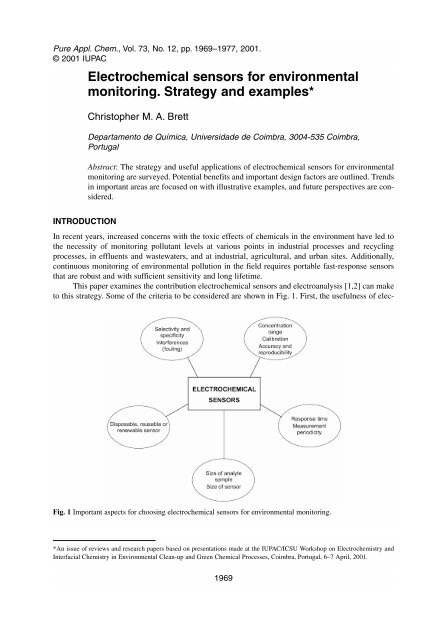
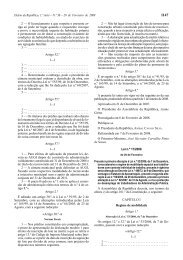
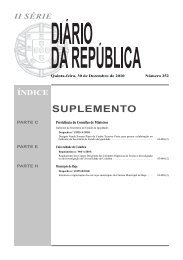
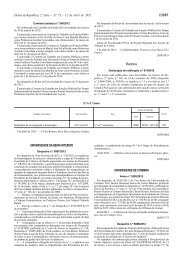
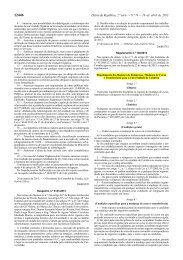
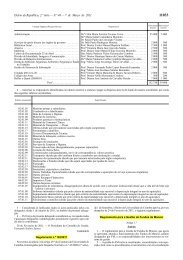

![RL #35 [quadrimestral. Julho 2012] - Universidade de Coimbra](https://img.yumpu.com/27430063/1/190x234/rl-35-quadrimestral-julho-2012-universidade-de-coimbra.jpg?quality=85)
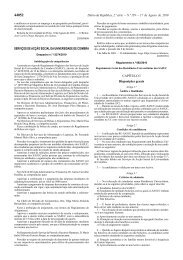

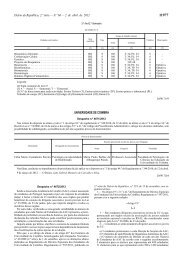
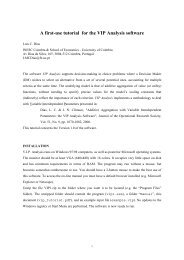


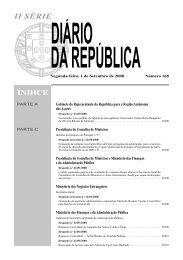
![RL #34 [quadrimestral. Março 2012] - Universidade de Coimbra](https://img.yumpu.com/27430022/1/190x234/rl-34-quadrimestral-marao-2012-universidade-de-coimbra.jpg?quality=85)